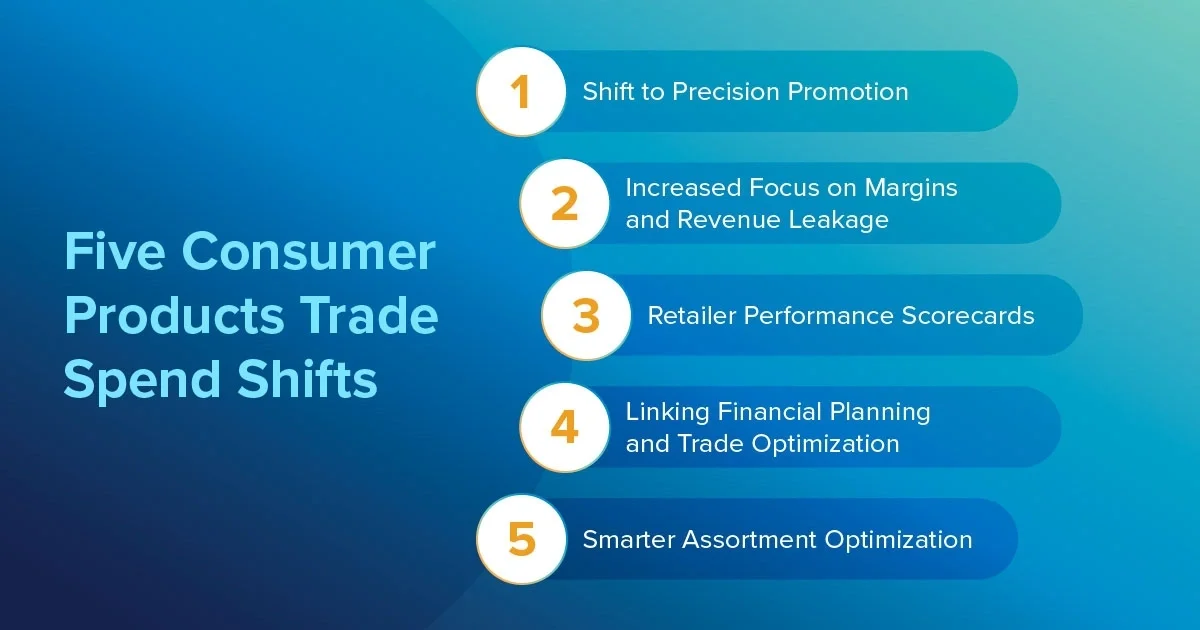
Trade Spend Trends Helping Manufacturers Traverse Tough Terrain
Consumer Products Trade Spend Trends: Turning Complexity into Competitive Advantage in 2026
Consumer products manufacturers are entering 2026 at a crossroads, one that demands agility and direction to find a good stride. Economic uncertainty, rising costs, evolving consumer behavior, and increasingly demanding retail partners are creating pressure to deliver both growth and profitability. At the same time, advancements in technology and analytics are offering new ways to optimize trade spend and turn complexity into a competitive advantage.
How can consumer products manufacturers navigate economic uncertainty and pricing pressures?
Manufacturers continue to face economic volatility. Margin pressure persists as input costs stabilize unevenly and retailers wield greater pricing power. While inflation has moderated, retailer demands for lower prices are compressing margins and placing trade budgets under greater scrutiny.
Understanding product “sensitivity factors”—the interplay between price elasticity and brand strength—has become essential. Over-promoting risks eroding brand equity, while under-promoting can lead to lost volume. Precisely calibrating trade spend is fundamental to protecting both market share and profitability, requiring the kind of balance and sure-footedness once reserved for athletes adapting to unpredictable terrain.
Omnichannel retailing stretches trade promotion budgets
Omnichannel retailing is further stretching trade budgets thinner. A smaller number of large retail partners expect performance-based funding and complete visibility into promotion outcomes across physical and digital channels. Manufacturers that unify trade planning, track ROI across channels, and collaborate with retailers on joint business planning can allocate spend more efficiently and strengthen retailer relationships.
Value-driven shoppers create unpredictable demand
Even as inflation stabilizes, shoppers remain highly value-conscious. This is driving even more growth in club, discount, and dollar channels. Traditional brand loyalty is increasingly fragmented, making demand signals less predictable and more obscured. Manufacturers that leverage advanced analytics and digital tools to interpret shifting behaviors can align promotions with actual purchase patterns and respond quickly to emerging trends, moving strides ahead of the competition.
Ways technology turns trade spend into a competitive advantage
Technology is transforming trade spend from a reactive cost into a strategic growth lever. Think of it like your trail run support crew, providing support across myriad needs. Modern revenue growth management (RGM) solutions provide unified reporting across accounts, brands, regions, and spend types. This offers a holistic view of promotion performance.
AI and advanced analytics enhance this capability by identifying demand patterns, simulating promotion scenarios, and forecasting outcomes with precision. While comprehensive point-of-sale and syndicated data remain prerequisites, manufacturers that operationalize these insights gain a significant advantage in predicting consumer behavior and optimizing trade spend.
Intelligent automation streamlines accrual tracking, deduction resolution, and claim validation, reducing manual effort and freeing teams to focus on strategic initiatives. Together, unified reporting, predictive analytics, and intelligent automation allow manufacturers to protect margins, drive revenue growth, and turn trade spend into a competitive differentiator.
Five consumer products trade spend trends redefining growth
1. Shift to Precision Promotion
Broad promotions are giving way to precision targeting. By designing offers by account, region, and shopper segment, manufacturers can deliver personalized deals that match purchasing trends, product affinities, and shopper constraints. AI tools can recommend new products, optimize ecommerce catalogs, enhance product descriptions, and adjust pricing in near real-time to maintain competitive positioning.
2. Increased Focus on Margins and Revenue Leakage
CFOs demand greater visibility into trade spend to protect profitability. Real-time reporting helps teams detect margin erosion early, manage deductions efficiently, and align investments with financial objectives across the organization and supply chain.
3. Retailer Performance Scorecards
Joint business planning is becoming more evidence-driven. Manufacturers rank and report trade effectiveness by retailer, enabling fact-based conversations that optimize funding, improve collaboration, and reinforce accountability for promotion outcomes.
4. Linking Financial Planning and Trade Optimization
Historically, demand planning has guided sales forecasts and P&L projections. But in today’s volatile environment, models built on last year’s results plus modest growth no longer hold. Traditional tools struggle to account for shifting consumer behavior—shoppers trading down, delaying purchases, or leaving categories altogether—making forecasts less reliable.
Integrating financial planning with trade optimization enables manufacturers to move beyond static assumptions. Modern optimization tools incorporate variables such as consumer sentiment, price elasticity, and competitive dynamics, improving forecast accuracy and responsiveness. This tighter connection between trade spend and financial planning gives organizations the agility to course-correct quickly, protect profitability, and adapt to market change.
5. Smarter Assortment Optimization
Optimizing product assortments from an economic and value perspective helps meet shopper needs while maximizing category growth. Similarly, before starting out on a technical trail, smart runners balance anticipated energy needs with nutrition and hydration intake.
Evaluating SKUs based on revenue and margin contribution informs promotions, rationalization decisions, and new product introductions.
Trade spend drives profitable agility for consumer products manufacturers
Consumer products manufacturers are at a pivotal point, facing unprecedented complexity and pressure to deliver growth and profitability. Rising costs, regulatory shifts, and evolving consumer behavior are challenging traditional trade spend strategies. Yet those companies that confront these challenges directly are demonstrating that volatility can be a source of opportunity.
Leading manufacturers are decoupling growth from price, accelerating adoption of technology and AI, preparing for regulatory impacts, and responding rapidly to shifting consumer demand. Success in 2026 will depend less on any single tactic and more on the ability to remain agile and coordinated. With the right strategies in place, you can earn the revered “mountain goat” nickname given to the most adaptable, agile runners over rugged terrain.
Get the latest news, updates, and exclusive insights from Vistex delivered straight to your inbox. Don’t miss out—opt in now and be the first to know!
